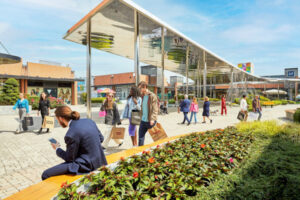By Lauriane Courtes
The 20 years that we have devoted to counting and analyzing visitor flow at shopping centers have given us great insight into the significant challenges confronting the analysis of what we call customer footfall. The first challenge is the environment: The shopping center of today is not the shopping center of tomorrow. By its very nature, a shopping center is in a constant state of evolution – special events, expansions, new stores replacing old ones, and simple maintenance work all have to be carried out while the center remains fully open to the public. A shopping center is a theater in which the visitors are invited to play out their own experiences. As a result, the center needs to be able to convince the customers to return and to treat them as privileged individuals while they are inside. One of the key assets of modern centers is the architecture itself – an appealing building attracts more and more visitors. The ingenuity of the architects makes it necessary for the techniques involved in capturing data to be capable of handling very different configurations, with immense variability in their characteristics – very high ceilings, broad thoroughfares, variable and constantly changing luminosity, doorways through which very dense traffic is expected, etc.
Measuring the trends and performance of such complex sites requires technology that can render reliable and precise information over the long term. At the same time, it must be capable of withstanding the effects of power outages, network malfunctions, and other technical problems, with the ability to recover or reconstitute data. Long-term reliability and accuracy are the sine qua non requirements for obtaining quality data capable of providing the necessary information to compare site performance. The data collected is essential for several levels within the company and is aimed at two major types of decision-making. Firstly, there is the day-to-day site management, for which information is required on a daily or weekly basis and in real-time. Secondly, on a more strategic level, a longer-term view – several months or quarters – is more appropriate since such information is required for making decisions regarding investments and expansions or even the divestment of a site.
The data is destined for people who have varying roles within the company. A center director does not need the same information as an operations director, who requires the overall information pertaining to several sites. The data needs to be provided in a personalized manner that is suited to the recipient – a perfect example of “one size does not fit all”. The data needs to reflect the requirements of the recipients, either for the understanding of a particular site or for a particular period. Whereas before the onset of Covid-19, real-time data concerning site occupancy was a measure of attractiveness, it is even more vital now, considering the latest pandemic challenge. In the current situation, such information has become essential when it comes to deciding on when shopping centers should be opened or re-opened, both in France and elsewhere in Europe.
In summary, quality counting for shopping centers must be based on reliable and precise data collected from all the diverse vantage points afforded by the various architectural eccentricities that can be found at today’s centers. Then, the data needs to be transformed into personalized information to meet the needs of each recipient. Thus, the analysis becomes a made-to-measure service provided in long-term cooperation with the ultimate customer.





